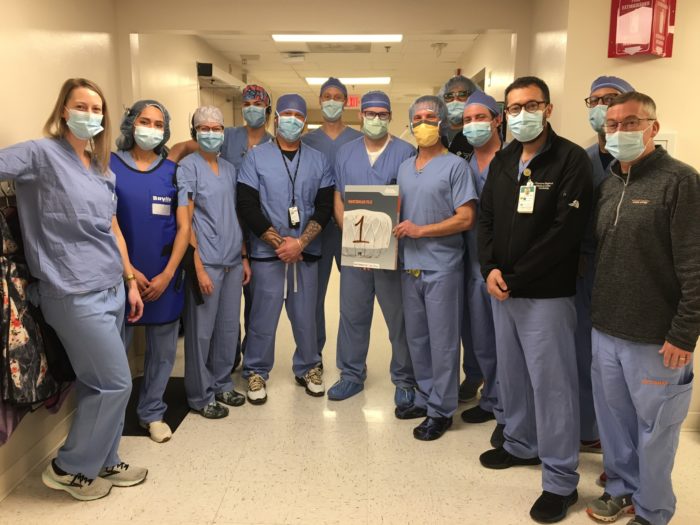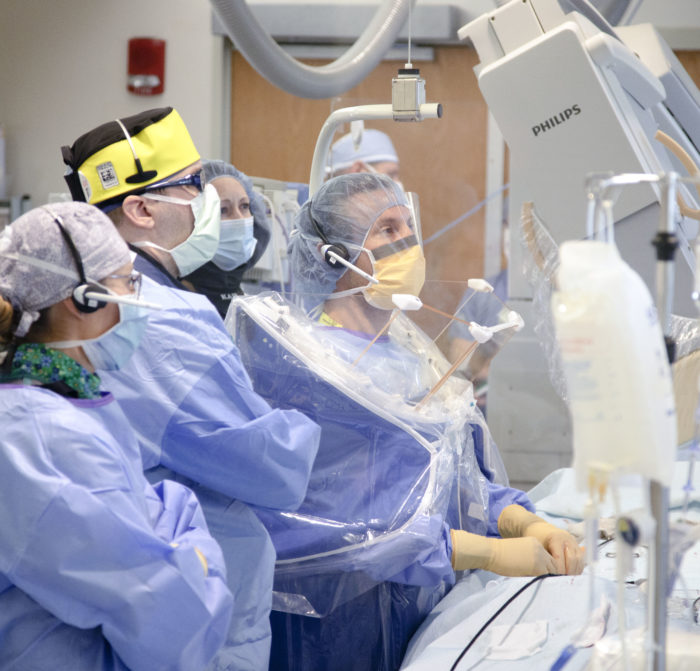CRMC Cardiac Electrophysiologists Successfully Implant Heart Device to Decrease Patient’s Stroke Risk
May 4, 2022
This next-generation permanent heart implant is the only FDA-approved device for the reduction of stroke risk in patients with non-valvular atrial fibrillation

CRMC and WATCHMAN team members that were part of the the WATCHMAN FLX implant procedure performed on March 2, 2022. This was the first time for this procedure to be performed at CRMC.
Cheyenne, WY—On March 2, 2022, two cardiac electrophysiologists at Cheyenne Regional Medical Center (CRMC) implanted a WATCHMAN FLX device in a patient’s heart to help reduce the patient’s risk of having a stroke.
CRMC is one of two hospitals in Wyoming to offer this implant procedure as an alternative to the lifelong use of blood thinners for individuals with atrial fibrillation (AFib) not caused by a heart valve problem. This was the first time for the procedure to be performed at CRMC.
“Everything went very well,” said Dr. Oussama Lawand, the lead cardiac electrophysiologist for the procedure performed that Wednesday morning. “The patient stayed one night in our Telemetry unit for observation and was feeling so good that she was able to go home the next day. I want to thank the CRMC cardiac electrophysiology and WATCHMAN teams for their support and assistance during that first procedure and also during the two implant procedures we did later in the day. It is a privilege to be able to offer this procedure to our community.”
The WATCHMAN device closes off an area of the heart called the left atrial appendage to keep harmful blood clots that can form in the fingertip-size pouch from entering the blood stream and potentially causing a stroke.
“By closing off the left atrial appendage, the risk of stroke can be reduced over time,” Dr. Lawand said. “Many patients who undergo this procedure can eventually stop taking blood thinners and avoid the bleeding and lifestyle changes associated with them.”
Up to 6 million Americans are estimated to have AFib, a condition in which the upper chambers of the heart beat too fast and with an irregular rhythm. People with AFib are five times more likely to have a stroke than people with normal heart rhythms, and more than 90 percent of all stroke-causing clots that come from the heart form in the left atrial appendage in individuals with non-valvular AFib.

Dr. Oussama Lawand works on implanting the WATCHMAN FLX device into a patient at CRMC on March 2, 2022.
“This procedure serves as a safe and effective stroke risk reduction alternative for patients with non-valvular atrial fibrillation, and especially for those individuals with a compelling reason not to be on blood thinners,” said Dr. Jason Rytlewski. Dr. Rytlewski assisted with the first procedure and was the lead cardiac electrophysiologist when the procedure was performed on another patient that afternoon.
In a clinical trial, 96 percent of participants were able to stop taking blood thinners 45 days after undergoing the WATCHMAN procedure. An analysis of 36,000 patients also found that it reduced the risk of stroke by 70 percent.
“While effective at reducing the risk of stroke, blood thinners increase the risk of serious bleeding over time and come with certain requirements and restrictions,” Dr. Rytlewski said. “Being able to offer this procedure to eligible individuals is often life-changing and will allow us to treat a broader range of patients going forward.”
To implant the device, the physician makes a small cut in the patient’s upper leg and inserts a narrow tube called a catheter that includes the WATCHMAN. The physician guides the device into the heart and then uses it to seal off the pouchlike left atrial appendage. The procedure is performed under general anesthesia and takes about an hour. Patients commonly stay in the hospital overnight and leave the next day. The device does not have to be replaced and can’t be seen outside the body.
More information about the WATCHMAN procedure is available by calling the Cheyenne Regional Medical Group Heart & Vascular Institute at (307) 637-1600.